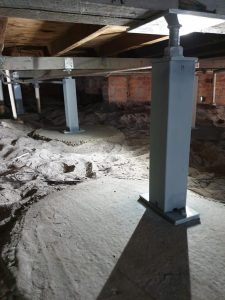What is Restumping?
Restumping, also known as reblocking, is the process of replacing the stumps or foundations that support a house. The stumps are usually made of timber or concrete and are located under the house to provide a stable foundation. Restumping a house is necessary when the stumps become damaged or deteriorated, which can cause the house to become unstable or uneven. In this article, we will discuss the process of restumping a house and why it is important

.
When is Restumping Necessary?
Restumping a house is necessary when the stumps that support the house become damaged or deteriorated. This can happen due to several factors, including:
Age: As houses get older, the stumps that support them can deteriorate and become less stable.
Soil movement: Changes in the soil due to moisture or subsidence can cause the stumps to shift or sink.
Termites: Termites can eat away at timber stumps, causing them to become weak and unstable.
Poor installation: If the stumps were not installed correctly, they may become unstable over time.
If left untreated, these issues can cause the house to become unstable, which can lead to structural damage, cracked walls, uneven floors, and other problems.
The Restumping Process
The restumping process involves several steps, including:
Inspecting the house:
An inspection will help you identify any areas that require attention, which can save you time and money in the long run.
During an inspection, a professional will evaluate the foundation of your house to determine if there are any signs of damage or wear and tear. They will also look for cracks or gaps in the walls and floors, as well as examine any sloping or unevenness in the ground around your home. These indicators could be signs that restumping is needed.
Once an inspection has been completed and it has been determined that restumping is necessary, work can begin on preparing your house for this process.
Excavation:
The excavation involves digging out all the old stumps from under your home. This can be a time-consuming process, but it is necessary to ensure that all the old stumps are removed before new ones are installed.
Stump removal:
The existing stumps are removed using a hydraulic jack, and the new stumps are put in place.
Leveling:
This step involves using specialized equipment such as spirit levels and laser levels to determine where the house is uneven. Once this has been established, old stumps are removed and new ones are installed in their place. These new stamps are usually made from concrete or steel for added durability.
It’s important to note that restumping should only be carried out by qualified professionals with experience in this field. Attempting to restump your own home can lead to serious damage if not done correctly.
Securing the stumps:
The new stumps are secured in place using concrete or other materials.
Finishing:
The excavated soil is replaced, and the area around the new stumps is leveled and compacted.
The restumping process can take several weeks to complete, depending on the size of the house and the extent of the damage. During the process, the house may be raised several inches off the ground, which can make it difficult to access the interior. Homeowners may need to temporarily relocate while the restumping is being done.
Benefits of Restumping
Restumping a house offers several benefits, including:
Stability:
Restumping ensures that the house has a stable foundation, which can prevent structural damage and other issues.
Safety:
A stable foundation can also make the house safer for occupants.
Value:
Restumping can increase the value of a home by improving its structural integrity.
Comfort:
Restumping can eliminate uneven floors and other issues that can make a house uncomfortable to live in.
Energy Efficiency:
Restumping can improve the energy efficiency of a house by reducing drafts and improving insulation.
Costs of Restumping
The cost of restumping a house can vary depending on several factors, including the size of the house, the number of stumps that need to be replaced, and the type of material used for the new stumps. In general, the cost of restumping can range from a few thousand dollars to tens of thousands of dollars.
It is important for homeowners to get multiple quotes from reputable restumping contractors before deciding on a contractor. Homeowners should also check the contractor’s credentials and ask for references from past clients to ensure that they are hiring a qualified and experienced professional.
In conclusion, restumping a house is an important process that helps to maintain the structural integrity of a property. It involves replacing old and damaged stumps with new ones to ensure that the foundation of the house remains strong and stable. While it can be a costly and time-consuming task, it is necessary for homeowners who want to ensure the safety and longevity of their homes. If you suspect that your house may need restumping, it is important to consult with a professional as soon as possible. Don’t wait until it’s too late – invest in the health of your home today!
